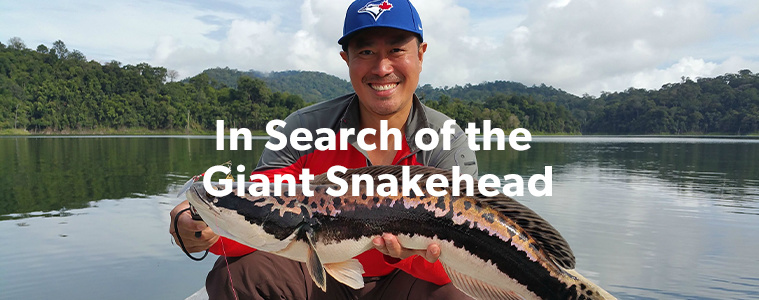In Search of the Giant Snakehead
- Posted on
- By Customer Submission: Marvin
- 0

The opportunity to fish a body of water tucked away deep in the world's oldest tropical rain forest doesn't come up often so when it did, I jumped at the chance. Besides, it was with my favourite fishing partner, my brother Kevin. Once the stronghold of communists up until 1989, The Royal Belum Forest Reserve in Perak, Malaysia dates back over 130 million years old, making it older than the Amazon and the Congo. In it lies Lake Temenggor, covering 15,200 hectares (1 hectare is about the size of a professional baseball field) and home to many species of freshwater fish like the hampala barb, Malaysian mahseer and channa micropeltes. Also known as the giant snakehead, it would be the main target species of our trip.
This man-made lake was created to aid in the fight against the communists by cutting off their lines of communication and supply lines, and also to generate electricity. Much of the lake is filled with submerged trees that provide a superb habitat for the 23 species of fish that live in it.
Snakehead have a bad reputation in the lower part of the United States, but it is a prized game fish in Asia. Imagine muskie or pike fishing, except these fish can still live after being out of water for several hours. While not necessarily an easy fish to catch, they can often be found in vulnerable circumstances (while coming up for air or guarding their young). These apex predators take turns guarding their young and will test the patience of even the most skilled angler. However, given the right conditions, it will strike at anything it sees as a threat (especially to its young). An added bonus is that snakehead do not shy away from displaying their aggression on topwater lures.
The first 2 days of fishing can be described as a typical snakehead fishing experience - hours of casting lures, stalking schools of fry, a few missed strikes and for some, landed fish. On the 3rd day, it was anything by typical. A day which I can only describe by borrowing from Franklin Roosevelt's speech - "a day that will live in infamy."
It started with our fishing guide bringing us along a stretch of river that looked seemingly innocent enough. It was slow flowing, shallow on one bank and sparsely dotted with broken tree branches sticking out of the water on the other. In fact, some of the guys had fished it on a previous trip but hadn't found it too productive.
That was soon about to change.
When approaching a potential snakehead habitat, there are a few rules-of-thumb to follow: be stealthy (turn off the motor, paddle in), be on the lookout for "rises" (adult snakehead coming up for air), schools of fry (coming up for air or to feed) and the most obvious, splashes along the surface to indicate adult snakehead feeding. Barely a minute in and we heard a surface splash. Then another. Then another. The fish were hungry, and you could feel the excitement building up so thick you could cut it with a knife.
Snakehead are known to be fiercely territorial, and to witness so much activity in a relatively confined area was a rare occurrence. Lures were soon flying through the air. There were lots of missed strikes, many fish landed and even more lost fish.
In 4 days of fishing, we had no less than 50 missed strikes and over 30 fish caught, pictured and released. This was a trip I'll never soon forget - fishing deep in an ancient rain forest, making new friends, and catching a ton of fish made for a truly wonderful fishing experience. Fishing-wise, it's safe to say we made out like bandits.

Comments
Be the first to comment...